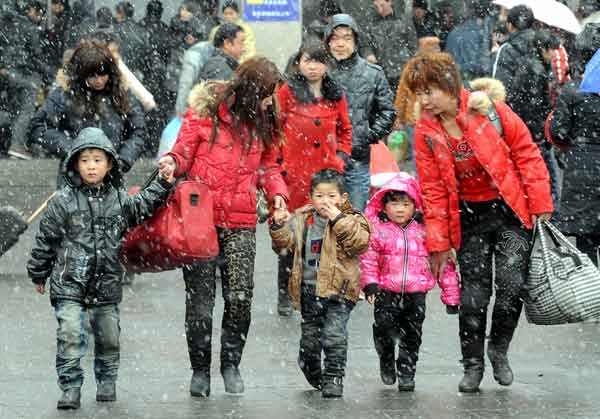Society
Record numbers return following festival
By Yan Jie, Wu Yiyao and Qiu Quanlin (China Daily)
Updated: 2011-02-10 07:30
 |
Large Medium Small |
Passengers walk out of the railway station in Zhengzhou, capital of Central China’s Henan province, on Wednesday as the first snow of the year fell on the city. [Photo/Xinhua]
More trains will run to cope with massive demand

BEIJING - Record numbers of travelers returned to their jobs in big cities during recent days as the seven-day Spring Festival holidays ended.
On Wednesday, the nation's railway operators planned to add a record 803 temporary passenger trains within a day to ease the transport burden, said the Ministry of Railways.
The number of travelers getting on trains on Tuesday totaled 6.88 million, up 13.5 percent from a day earlier. It was a record for the Spring Festival travel peak, said the ministry.
As of Tuesday, which was the 21st day of the Spring Festival travel season, the country's railways had conveyed a total of 106.63 million passengers, which was up 9.8 percent on the same period last year.
The large numbers of people on the move will continue until the end of the month as students and migrant workers return to big cities including Beijing, Shanghai and Guangzhou from their hometowns, the ministry said.
The annual Spring Festival travel season, dubbed the world's biggest human migration, runs from Jan 19 to Feb 27 this year.
The majority of travelers during the past two days set out from Hubei, Hunan and Sichuan provinces, and Chongqing municipality, according to the Ministry of Railways.
By Wednesday afternoon, part of Central China, including Henan province, had begun to see snow and sleet falling, said the National Meteorological Center on its website. The forecast had prompted the railway ministry to order its subsidiaries in the area to be prepared for bad weather.
In Beijing, the city's four railway stations recorded a total of 350,000 arrivals on Tuesday, according to the Beijing News. The arrivals formed long queues in front of Beijing Railway Station as people waited to get into the subway station.
And Shanghai has witnessed a passenger rush that surpassed any previous year.
Shanghai's railway administration counted more than 5 million travelers between Feb 2 and Tuesday. Nearly 1 million passengers traveled by train from and to Shanghai on Tuesday.
It is estimated that more than 38 million passengers will travel through Shanghai by the time the peak travel season is over, according to Tao Liping, a spokesman with the Shanghai railway bureau.
Airports in Shanghai have also been busy, despite a rise in the cost of tickets. A total of 9,664 flights have taken off and landed at the city's two airports, carrying more than 1.23 million passengers between Feb 2 and Tuesday, up by 13.7 percent year-on-year, according to the Shanghai airport authority.
The falling temperatures may make travel more difficult in the days to come with strong cold gusts of air hitting the north of Shanghai.
The lowest temperature is likely to come on Feb 12 when temperatures will fall below freezing, according to the Shanghai Meteorological Center on Wednesday.
In Guangzhou, 4.8 million passenger trips by train, a year-on-year increase of 35 percent, were recorded between Feb 3 and Wednesday, sources with the Guangzhou Railway Group Co said.
The passenger surge was mainly due to the opening of the Guangzhou-Zhuhai intercity railway and the increased passenger capacity of the Wuhan-Guangzhou high-speed line, said the railway group spokesman He Zhiwen.
Tickets for trains along the Wuhan-Guangzhou high-speed line are sold out for the next two days, He added.
"The passenger flow peak is yet to come because more migrant workers are expected to return in the following days," He said.
On the roads, increased traffic flows have hit many highways in Guangdong.
More than 100,000 passengers were recorded at the Tianhe, Shengzhan and Shizhan coach terminals in Guangzhou on Wednesday.
The volume on the roads has caused severe traffic jams along the Shenzhen-Shantou expressway, a major link between the Pearl River Delta and the eastern side of Guangdong province.
"I have never experienced such a big jam," said Liu Danjing, who took more than 12 hours to travel from Shantou to Guangzhou on Tuesday. "Usually, it only takes about five hours to drive from my hometown to Guangzhou."
China Daily
(China Daily 02/10/2011 page3)